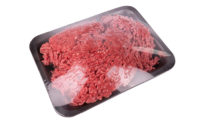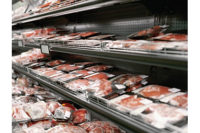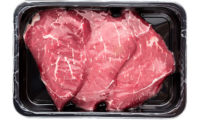Overwrapping and modified-atmosphere packaging (MAP) protect the freshness of meat, poultry and seafood and extend the shelf life. Overwrapping continues to dominate, particularly for store-packaged and case-ready beef, but MAP enjoys a solid position. MAP is seen for value-added items such as meatballs and an array of case-ready products, especially poultry. In fact, a casual study of refrigerated cases at grocery stores shows MAP appears to have captured the ground turkey segment.
It’s not surprising, really, since MAP can add several days — even weeks — of shelf life. In addition, hermetic seals eliminate leaky packages, a consumer turn-off, and printed film offers the potential for strengthening brand identity with enhanced graphics.
MAP alters the atmosphere inside a package by replacing it with a single gas or mixture of gases. A fact sheet on MAP from the Canadian Meat Council states, “The ratio of oxygen, nitrogen, carbon dioxide and/or carbon monoxide [if permitted] is altered to best suit the food product.” Multilayer barrier materials are required to maintain the atmosphere. Layers can be coated, coextruded or laminated, and generally add to the cost of the packaging. But technological advances are cutting costs by enabling downgauging. As a result in some cases, the required barrier performance can be delivered by materials as thin as 50 microns.
MAP also may benefit from the addition of an oxygen absorber. For jerky, an oxygen-absorbing packet can be dispensed automatically to maintain oxygen levels at less than 0.01 percent in the sealed pack. Maintaining this low level of oxygen helps protect the jerky from spoilage and flavor loss and boosts shelf life beyond what it would be with gas flushing or vacuum packaging alone.
Another oxygen-absorbing technology, a self-adhesive label-like construction, is designed to be applied to the interior of deli meat packages to extend shelf life. Oxygen absorbers also can help optimize in-pack conditions for case-ready fresh meat.
On a broader scale, oxygen management can control the atmosphere in refrigerated shipping containers, extending the shelf life of fresh seafood beyond 40 days. The longer freshness window allows shipments to be made by sea rather than more expensive air freight.
Overwrapping, whether in a processor or retail setting, benefits from fully automated machines, integrated weighing/labeling and high-quality, on-demand label printing. Today’s overwrappers handle a wide range of tray sizes with the same width of stretch film and minimal, if any, changeover adjustments. Tightly wrapped packages are delivered at speeds up to 120 packs per minute. The compact machines occupy relatively small footprints and are designed for lower film consumption. A touch-screen operator interface, programmable controls, self-diagnostics and remote troubleshooting simplify operation, cleaning and maintenance. Advanced networking capability links the machine to other systems, a necessity for compliance with traceability requirements.
The resulting overwrapped packages are leak-resistant, and a popular choice for processors including Bob Evans Farms, Inc., in New Albany, Ohio, which relies on overwrapped black trays for its pork sausage patties and links.
The other change in overwrapping relates to tray color. The once-ubiquitous white foam trays have been replaced almost entirely with different colors. Although yellow is popular for poultry, black trays with an absorbent pad, if needed, seem to be ruling the red-meat case. The black surface not only contrasts well with the product, but also provides a cleaner, more elegant appearance. NP





Report Abusive Comment